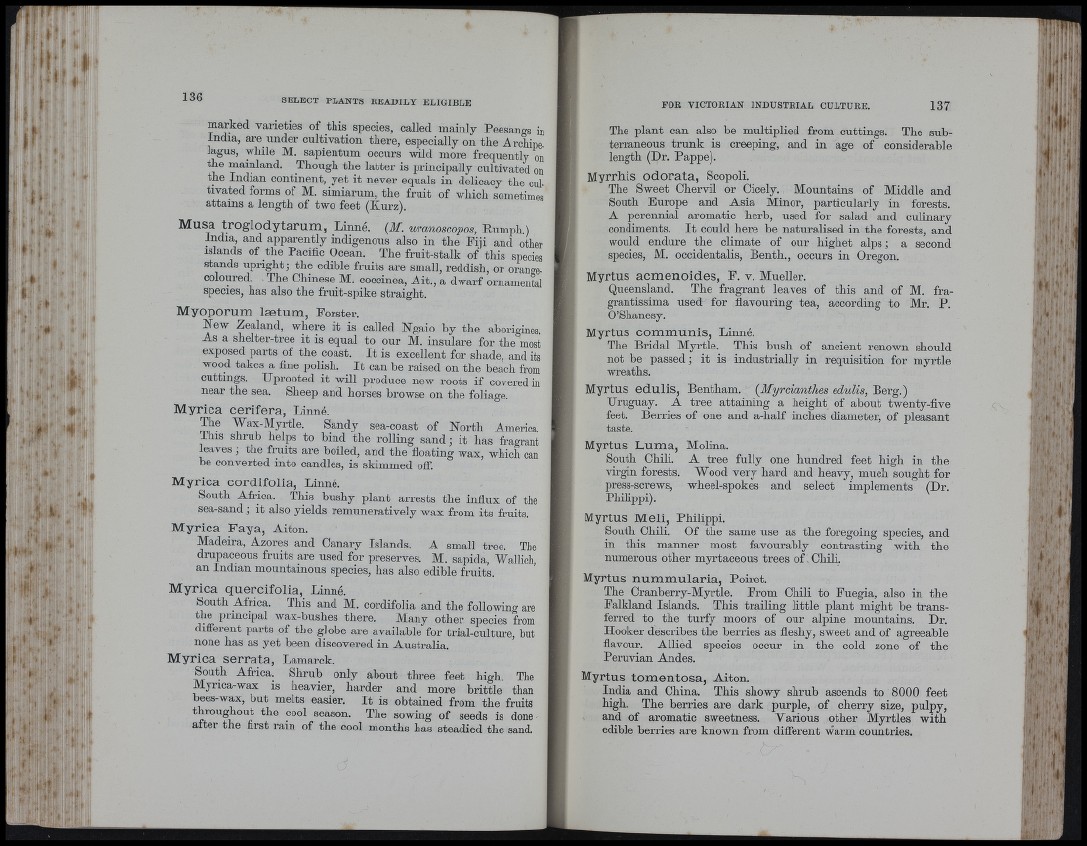
.. {
' I'
;
SELECT PLANTS READILY ELIGIBLE
marked varieties of this species, called mainly Peesangs in
India, are under cultivation there, especially on the Archipe.
laguSj while M. sapientum occurs wild moi'e frequently on
the mainland. Though the latter is principally cultivated on
the Indian continent, yet it never equals in delicacy the cul
tivated forms of M. simiarum, the fruit of which sometimes
attains a length of two feet (Kurz).
Musa troglodytarunij Linne. {M. uranoscopos, Pnmph )
India, and apparently indigenous also in the Fiji and other
islands of the Pacific Ocean. The fruit-stalk of this species
stands upright; the edible fruits are small, reddish, or orange-
coloured The Chinese M. coccinea, Ait., a dwarf ornamental
species, has also the fruit-spike straight.
Myoporum lætum, Forster.
New Zealand, where it is called Ngaio by the aborigines,
As a shelter-tree it is equal to our M. insulare for the most
exposed parts of the coast. I t is excellent for shade, and its
wood takes a fine polish. I t can be raised on the beach from
cuttings. Uprooted it will jiroduce new roots if covered in
near the sea. Sheep and horses browse on the foliage.
Myrica cerifera, Linné.
The Wax-Myrtle. Sandy sea-coast of North America.
I his shrub helps to bind the rolling sand; it lias fragrant
leaves, tbe fruits are boiled, and the floating wax, which can
be converted into candles, is skimmed off.
Myrica cordifolia, Linné.
South Africa. This bushy plant arrests the influx of the
sea-sand ; it also yields remuneratively wax from its fruits.
Myrica Faya, Aiton.
Madeira, Azores and Canary Islands. A small tree. The
drupaceous fruits are used for preserves. M. sapida, Wallich,
an Indian mountainous species, has also edible fruits.
Myrica quercifolia, Linné.
South Africa. This and M. cordifolia and the following are
the piincipal wax-busbes there. Many other species from
difierent parts of tbe globe are available for trial-culture, but
none has as yet been discovered in Australia.
Myrica serrata, Lamarck.
South Africa. Shrub only about three feet high. The
Myrica-wax is heavier, harder and more brittle than
bees-wax, but melts easier. I t is obtained from the fruits
throughout the cool season. The sowing of seeds is done
after the first rain of the cool months has steadied the sand.
■
FOR VICTORIAN INDUSTRIAL CULTURE. 137
The plant can also be multiplied from cuttings. The subterraneous
trunk is creeping, and in age of considerable
length (Dr. Pappe).
Myrrhis odorata, Scopoli.
The Sweet Chervil or Cicely. Mountains of Middle and
South Europe and Asia Minor, particularly in forests.
A perennial aromatic herb, used for salad and culinary
condiments. I t could here be naturalised in tbe forests, and
would endure the climate of our bigbet alps; a second
species, M. occidentalis, Benth., occurs in Cregon.
Myrtus acmenoides, E. v. Mueller.
Queensland. The fragrant leaves of this and of M. fragrantissima
used for flavouring tea, according to Mr. P.
O’Shanesy.
Myrtus communis, Linné.
The Bridal Myrtle. This bush of ancient renown should
not be passed ; it is industrially in requisition for myrtle
wreaths.
Myrtus edulis, Bentham. {Myrciantlies edulis, Berg.)
Uruguay. A tree attaining a height of about twenty-five
feet. Berries of one and a-half inches diameter, of pleasant
taste.
Myrtus Luma, Molina.
South Chili. A tree fully one hundred feet high in the
virgin forests. Wood very hard and heavy, much sought for
press-screws, wheel-spokes and select implements (Dr.
Philippi).
Myrtus Meli, Philippi.
South Chili. Of the same use as the foregoing species, and
in this manner most favourably contrasting with the
numerous other myrtaceous trees of Chili.
Myrtus nummularia, Poii-et.
The Cranberry-Myrtle. Erom Chili to Euegia, also in the
Falkland Islands. This trailing little plant might be transferred
to the turfy moors of our alpine mountains. Dr.
Hooker describes the berries as fleshy, sweet and of agreeable
flavour. Allied species occur in the cold zone of the
Peruvian Amdes.
Myrtus tomentosa, Aiton.
India and China. This showy shrub ascends to 8000 feet
high. The berries are dai’k purple, of cherry size, pulpy,
and of aromatic sweetness. Various other Myrtles with
edible berries are known from difierent warm countries.
! Uf' I ■ : ■ ■
II j
I -
I „ J
"I. I 1
r , I
I